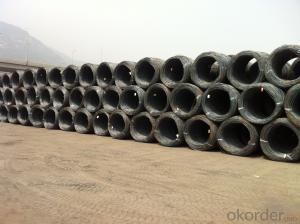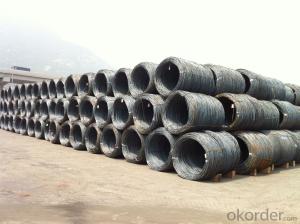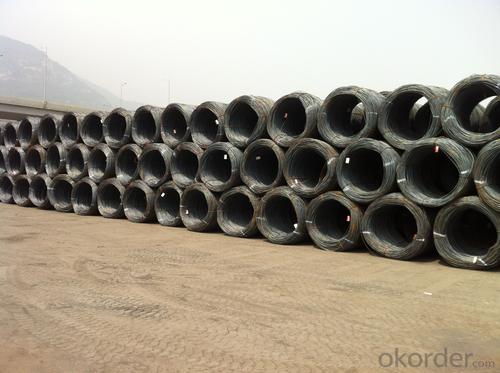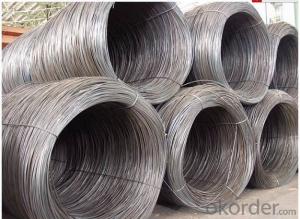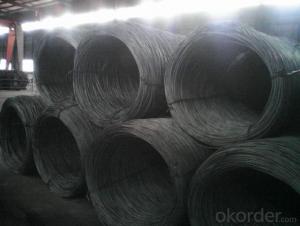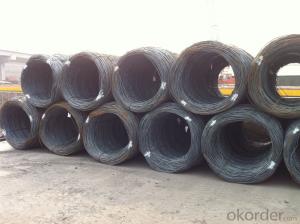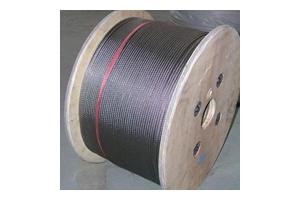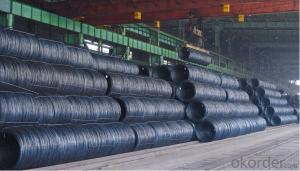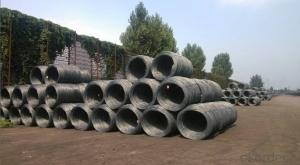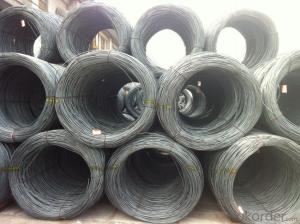Hot Rolled Wire Rods With High Quality and Best Price
- Loading Port:
- Tianjin
- Payment Terms:
- TT OR LC
- Min Order Qty:
- 25 m.t
- Supply Capability:
- 20000 m.t/month
OKorder Service Pledge
OKorder Financial Service
You Might Also Like
Specification
OKorder is offering Hot Rolled Carbon Steel Wire Rod 5.5mm with High Quality at great prices with worldwide shipping. Our supplier is a world-class manufacturer of steel, with our products utilized the world over. OKorder annually supplies products to European, North American and Asian markets. We provide quotations within 24 hours of receiving an inquiry and guarantee competitive prices.
Product Applications:
Hot Rolled Carbon Steel Wire Rod 5.5mm with High Quality is widely used in construction and manufacturing. Carbon steel wire rod is mainly used for reinforcement of reinforced concrete and welded structure or reprocessed (roberts , nail, etc.) materials, especially used to produce wire drawing, welding electrode, nails, spring, electronic, precise machinery parts and so on.
Product Advantages:
OKorder's Hot Rolled Carbon Steel Wire Rod 5.5mm with High Quality are durable, strong.packed and suitable for wire mesh,nail manufacture and construction
Main Product Features:
· Premium quality
· Prompt delivery & seaworthy packing (30 days after receiving deposit)
· Can be recycled and reused
· Mill test certification
· Professional Service
· Competitive pricing
Product Specifications:
Manufacture: Hot rolled
Grade: SAE1006 SAE1008 SAE1010 SAE1012 SAE1016 SAE1018
Certificates: ISO, SGS, BV, CIQ
Weight per Coil:2-2.05tons
Packaging: Export packing, packed by coil
Grade | Chemical Composition (%) | |||||
C | Mn | S | P | Si | B | |
SAE1006B | 0.03~O.07 | 0.32max | 0.045max | 0.040max | 0.30max | 0.0008min |
Mechanical properties | ||||||
Yield strength(N/mm2) | Tensile strength(N/mm2) | Elongation (%) | ||||
250-280 | 350-380 | ≥32 | ||||
Grade | Chemical Composition (%) | |||||
C | Mn | S | P | Si | B | |
SAE1008B | 0.10max | 0.3~0.50 | 0.050max | 0.040 max | 0.15max | 0.0008 min |
Mechanical properties | ||||||
Yield strength(N/mm2) | Tensile strength(N/mm2) | Elongation (%) | ||||
≥195 | 315-430 | ≥30 | ||||
FAQ:
Q1: Why buy Materials & Equipment from OKorder.com?
A1: All products offered byOKorder.com are carefully selected from China's most reliable manufacturing enterprises. Through its ISO certifications, OKorder.com adheres to the highest standards and a commitment to supply chain safety and customer satisfaction.
Q2: How do we guarantee the quality of our products?
A2: We have established an advanced quality management system which conducts strict quality tests at every step, from raw materials to the final product. At the same time, we provide extensive follow-up service assurances as required.
Q3: How soon we can delivery the goods ?
A3: We have a mill with 20000mts of capacity per month. We can delivery the goods within in one month ,as long as your order quantity less than 20000mts.
Q4: How many tons can be loaded into one 20ft container?
A4: Around 18—20tons,9-10 coils.
Image:

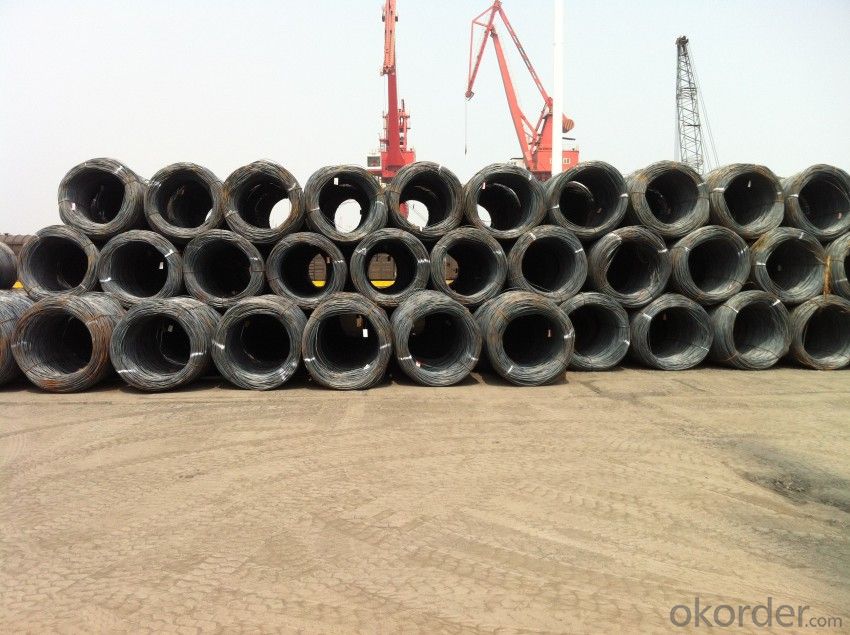
- Q: What are the different surface coating materials used for steel wire rod?
- There are several different surface coating materials that can be used for steel wire rod to enhance its properties and protect it from corrosion. Some of the commonly used surface coating materials for steel wire rod include: 1. Zinc: Zinc coating is one of the most widely used surface coatings for steel wire rod. It provides excellent corrosion resistance and acts as a sacrificial layer, protecting the underlying steel from rust and oxidation. Zinc-coated steel wire rods are commonly known as galvanized wire rods. 2. Epoxy: Epoxy coatings are often used for steel wire rods that require resistance to chemicals, moisture, and abrasion. Epoxy coatings provide a durable, smooth, and protective layer that helps to prevent corrosion and improve the overall performance of the wire rod. 3. Phosphating: Phosphating is a surface treatment process that involves the conversion of the metal surface into a layer of phosphate crystals. Phosphating enhances the adhesion of subsequent coatings or paints, providing better corrosion resistance and improving the overall appearance of the steel wire rod. 4. Polymer Coatings: Polymer coatings are commonly used for steel wire rods that require specific properties such as electrical insulation, UV resistance, or high temperature resistance. These coatings are typically made from polymers such as PVC (polyvinyl chloride) or PE (polyethylene) and are applied using various techniques such as extrusion or dip coating. 5. Organic Coatings: Organic coatings, such as paints or lacquers, can also be used as surface coatings for steel wire rods. These coatings provide aesthetic appeal, as well as protection against corrosion and environmental factors. Organic coatings can be applied in various colors and finishes to meet specific requirements. It is important to note that the choice of surface coating material for steel wire rod depends on the intended application, environmental conditions, and desired properties. Manufacturers typically select the most suitable coating material based on the specific requirements of the wire rod and the end-use of the product.
- Q: How is steel wire rod used in the manufacturing of wire mesh shelves?
- Steel wire rod is used in the manufacturing of wire mesh shelves by being drawn and annealed to form thin, strong wires. These wires are then woven or welded together to create the mesh structure of the shelves, providing excellent strength and stability for holding various items.
- Q: What are the different sizes of steel wire rod available?
- The sizes of steel wire rod available vary depending on the specific requirements and applications. They can range from small diameters, such as 1.5mm, up to larger sizes like 25mm or even more. The available sizes are determined by the manufacturing process and the intended use of the steel wire rod.
- Q: What are the different surface defects that can affect the fatigue life of steel wire rod?
- Some common surface defects that can affect the fatigue life of steel wire rod include surface cracks, pitting corrosion, surface decarburization, and surface roughness. These defects can weaken the structural integrity of the wire rod, leading to premature failure under cyclic loading conditions.
- Q: How is steel wire rod used in the manufacturing of wire for shipbuilding applications?
- The manufacturing of wire for shipbuilding heavily relies on steel wire rod due to its superior strength and durability. To begin the process, high-quality steel wire rod is carefully selected as the raw material. Thorough inspection and testing are conducted on the steel wire rod to ensure it meets industry standards for strength, corrosion resistance, and other essential properties. Once it passes these tests, the wire rod proceeds to the wire drawing process. During the wire drawing process, the steel wire rod is repeatedly pulled through dies to decrease its diameter and increase its length. This procedure is repeated until the desired diameter and length of the wire are achieved. Additionally, the wire drawing process enhances the wire's strength and surface quality, making it ideal for shipbuilding applications that require high tensile strength and corrosion resistance. Following the wire drawing process, the wire often undergoes additional treatments, such as annealing or heat treatment, to further enhance its mechanical properties. These treatments improve the wire's strength, ductility, and resistance to fatigue, ensuring it can withstand the demanding conditions encountered in shipbuilding. Once the wire has been processed and treated, it is wound onto large reels or coils for easy handling during the shipbuilding process. The wire is then utilized in various shipbuilding applications, including structural supports, cables, rigging, and other critical components that demand exceptional strength and durability. In summary, steel wire rod is of utmost importance in the manufacturing of wire for shipbuilding. Its ability to provide the necessary strength, durability, and corrosion resistance required in marine environments makes it an indispensable material in constructing ships capable of withstanding the challenges of the sea.
- Q: How is steel wire rod used in the manufacturing of wire for shipbuilding applications?
- The manufacturing of wire for shipbuilding heavily relies on steel wire rod due to its superior strength and durability. To begin the process, high-quality steel wire rod is carefully selected as the raw material. Thorough inspection and testing are conducted on the steel wire rod to ensure it meets industry standards for strength, corrosion resistance, and other essential properties. Once it passes these tests, the wire rod proceeds to the wire drawing process. During the wire drawing process, the steel wire rod is repeatedly pulled through dies to decrease its diameter and increase its length. This procedure is repeated until the desired diameter and length of the wire are achieved. Additionally, the wire drawing process enhances the wire's strength and surface quality, making it ideal for shipbuilding applications that require high tensile strength and corrosion resistance. Following the wire drawing process, the wire often undergoes additional treatments, such as annealing or heat treatment, to further enhance its mechanical properties. These treatments improve the wire's strength, ductility, and resistance to fatigue, ensuring it can withstand the demanding conditions encountered in shipbuilding. Once the wire has been processed and treated, it is wound onto large reels or coils for easy handling during the shipbuilding process. The wire is then utilized in various shipbuilding applications, including structural supports, cables, rigging, and other critical components that demand exceptional strength and durability. In summary, steel wire rod is of utmost importance in the manufacturing of wire for shipbuilding. Its ability to provide the necessary strength, durability, and corrosion resistance required in marine environments makes it an indispensable material in constructing ships capable of withstanding the challenges of the sea.
- Q: What are the regulations governing the production and use of steel wire rod?
- The regulations governing the production and use of steel wire rod vary by country and region. However, some common regulations include quality standards, safety requirements, and environmental regulations. These regulations aim to ensure that steel wire rod is produced and used in a safe and environmentally responsible manner, while also meeting the required quality standards.
- Q: What are the common production processes for zinc-coated steel wire rod?
- The common production processes for zinc-coated steel wire rod include cleaning and pickling the steel wire rod, coating it with a layer of zinc through hot-dip galvanizing or electro-galvanizing, and finally, coiling the zinc-coated wire rod for packaging and transportation.
- Q: What are the safety requirements for steel wire rod used in ski lift wire ropes?
- The safety requirements for steel wire rod used in ski lift wire ropes are crucial to ensure the safe and reliable operation of ski lifts. These requirements are designed to minimize the risk of accidents and maintain the structural integrity of the wire ropes. Firstly, the steel wire rod used in ski lift wire ropes must meet specific material standards. It should be made from high-quality, high-strength steel that is capable of withstanding the tension and stress encountered during ski lift operations. The wire rod should adhere to international standards such as ASTM A1023/A1023M or EN 12385, which specify the minimum mechanical properties and chemical composition of the wire rod. In addition to material requirements, the wire rod must undergo rigorous testing and inspection processes. This includes non-destructive testing techniques like ultrasonic examination, magnetic particle inspection, and visual inspection to identify any defects or imperfections in the wire rod. The testing should be performed by certified and qualified personnel to ensure accuracy and reliability. Furthermore, the wire rod used in ski lift wire ropes must have a specific diameter and tolerance range to maintain the desired strength and performance. Ski lift manufacturers typically provide specifications that dictate the required diameter and tolerance for the wire rod to be used in their systems. These specifications should be followed closely to ensure compatibility and safety. It is also essential to consider the surface requirements of the wire rod. The wire rod should have a smooth and clean surface, free from any burrs, cracks, or other surface defects that could compromise the structural integrity of the ski lift wire ropes. Any surface irregularities should be addressed through appropriate surface treatments or inspections. Lastly, regular maintenance and inspection of the ski lift wire ropes are necessary to ensure ongoing safety. This includes visual inspections, lubrication, and tension checks to detect any signs of wear, corrosion, or fatigue. If any issues are identified, immediate action should be taken to repair or replace the affected wire ropes to prevent accidents or failures. Overall, the safety requirements for steel wire rod used in ski lift wire ropes encompass material standards, testing, dimensional specifications, surface quality, and ongoing maintenance. Adhering to these requirements ensures the reliability and safety of ski lifts, providing a secure and enjoyable experience for skiers.
- Q: What are the main factors affecting the market sales of steel wire rod?
- The main factors affecting the market sales of steel wire rod include demand from various industries such as construction, automotive, and manufacturing, global economic conditions, price fluctuations of raw materials like iron ore and scrap metal, competition from alternative materials, technological advancements in production processes, and government policies and regulations pertaining to the steel industry.
Send your message to us
Hot Rolled Wire Rods With High Quality and Best Price
- Loading Port:
- Tianjin
- Payment Terms:
- TT OR LC
- Min Order Qty:
- 25 m.t
- Supply Capability:
- 20000 m.t/month
OKorder Service Pledge
OKorder Financial Service
Similar products
Hot products
Hot Searches
Related keywords
